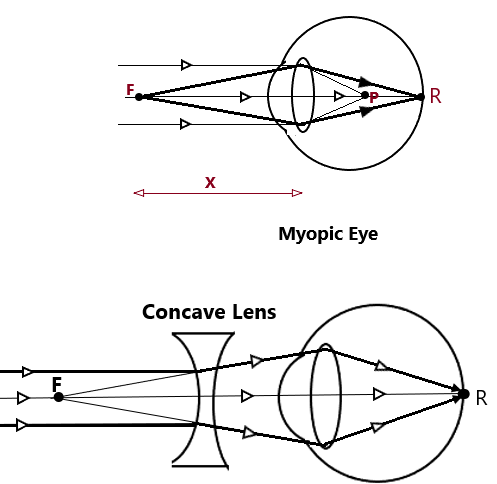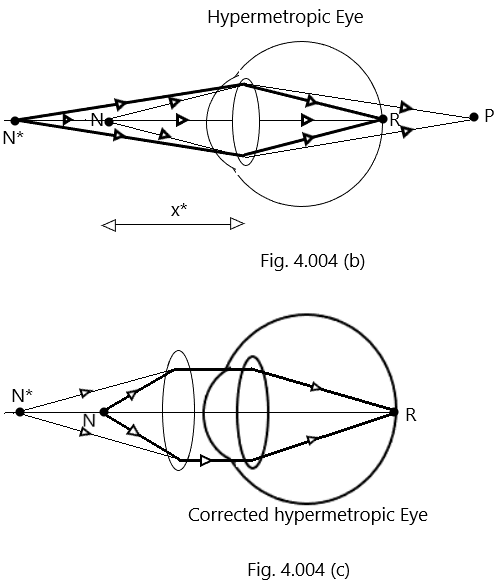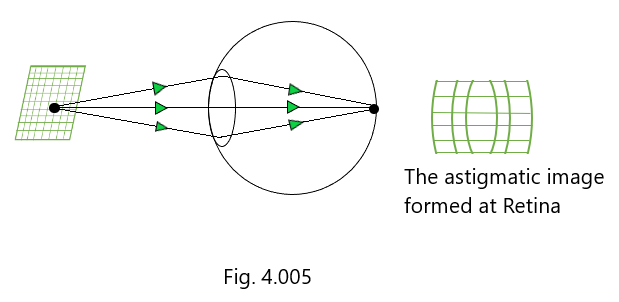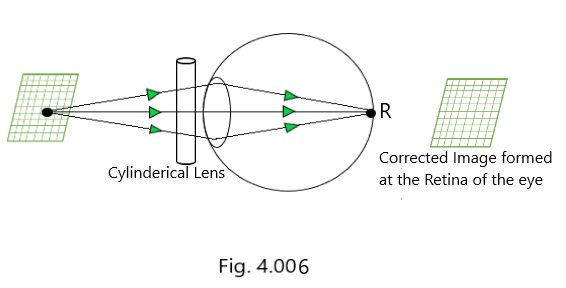Defects of vision
Defects of vision
A person with a normal eye can see the objects lying between near points and the far points (infinity for normal eyes)
A person with a normal eye can see the objects lying between near points and the far points (infinity for normal eyes) The distance between the near point and the far point is called the range of vision. But due to biological, physiological, and some other reasons, the disorders occur in the proper function of the eye. The most common disorders found are refractive types of errors. The Refractive type of error when the eye cannot focus the light properly, resulting in the formation of blurred images on the retina. Myopia (near-sightedness), hyperopia (far-sightedness), presbyopia (loss of near vision due to age), etc. are a few examples of refractive errors. (Defects of vision)
Myopia:
Myopia is a refractive error of the eye when a person suffering from it can see nearby objects quite clearly but distant objects cannot be seen distinctly and implying that the objects lying beyond a particular distance cannot be seen properly by the eye. In other words, it can be stated that for a myopic eye, the far point shifts towards the eye and so the images are focused before the retina. (Defects of vision) Reason for Myopia: There are mainly two reasons for the occurrence of this defect: (a) the increase in the curvature of the lens (increase in convexity of the lens) (b) the elongation of the eyeball (the eyeball is too long)- (Defects of vision)
Correction of Myopia: The myopia is a refractive defect in the vision of the eye which can be corrected by using the concave lens of suitable focal length. (Defects of vision)


The parallel rays of light from an object at infinity, in the case of a healthy and normal eye, are focused on the retina of the eye as shown in [Fig. 4.002]. But in the case of an eye suffering from myopia, the parallel rays of light are focused at a point just before the retina which results in the formation of a blurred image of the object as shown in [Fig. 4.003](Defects of vision)
The parallel rays of light from an object placed at infinity are focused at a point P just before the retina for a myopic eye and suppose that F is the far point for the myopic eye. When a diverging lens (concave lens) is placed between the far point F and the myopic eye, it diverges the light rays such that it appears to come from the far point F of the eye lens. Let us suppose that x is the distance of the far point of the myopic eye and the focal length of the concave lens is f, then.

Therefore, the concave lens to be used for correcting myopic defects in the human eye must be of a focal length equal to the distance from the far point of the defective eye. (Defects of vision).
Hypermetropia ( Long sightedness)
A person is said to be suffering from hypermetropia or long-sightedness when he can see far-off and distant objects clearly and distinctly but cannot see the objects which are placed nearer than a certain distance. This type of refractive defect comes into existence when the image of the object placed at a near point is focused beyond the retina. However, the image from a point N* is formed on the retina. (Defects of vision)
Reason for Hypermetropia: As per the clinical observations, hypermetropia may arise due to two reasons: (A) The eyeball becomes too small, and (B) the focal length of the lens has increased. (Defects of vision)
Correction of Hypermetropia: The hypermetropia is a refractive defect in the vision of the eye which can be corrected by using the convex lens of suitable focal length. (Defects of vision)


The rays of light starting from the object placed at near point N which is the distance of distinct vision for a normal and healthy eye, must fall on the retina so that a clear image is formed there as shown in Fig. 4.004(a).
But in case the eye suffers from hypermetropia, these rays are focused beyond the retina at some point (say) P as shown in Fig. 4.004 (b). The image viewed at point P will not be a clear one but will be blurred. In order to correct this refractive defect, we use a converging lens before the defective eye so that the light ray appears to come from point N* which is the near point for the defective eye. (Defects of vision)
Thus, the light rays after the refraction from the correcting lens, will be focused on the retina making a clear and distinct image there on it. (Defects of vision)
Let us consider that x* is the distance of the near point N* of the defective eye, D is the least distance of distinct vision of the normal eye and f is the focal length of the convex lens to be used as correcting lens, then using sign conventions, we can write, (Defects of vision)

Since, x* > D, so it is clear that we have to use the correcting lens of positive focal length, thus, we use a convex lens for this purpose. (Defects of vision)
Presbyopia:
The farsightedness occurring with increasing age is called Presbyopia. This is the defect of the eyeball that arises due to the old age of a person. The power of accommodation of the human eye decreases as one grows older and older and as a consequence, the near point gradually recedes away. This defect of the human eye is called Presbyopia. A person who suffers from presbyopia may suffer from both myopia and hypermetropia simultaneously.
Reason for the defect: This defect generally arises due to the gradual decrease of the strength and weakening of the ciliary muscles and a decrease in the eye lens flexibility. The ciliary muscles do not remain strong enough to exert tension on the crystalline lens to change its curvature. (Defects of vision)
Correction of presbyopia: This defect is annulled by using a bifocal lens with proper and suitable power of the lens. A bifocal lensto be used to correct presbyopia is a combination of a convex lens and a concave lens in the spectacles. The lower portion consists of a convex lens while the upper portion consists of a concave lens. (Defects of vision)
Cataract:
The eye lens of a person suffering from cataracts becomes milky and cloudy. Due to this reason, the image of an object is not visible as distinct and clear rather it is observed as hazy and unclear. Prolonged existence of the cataract can cause a complete or a partial loss of vision. The reason of occurrence of this defect is due to the formation of an opaque membrane over the eye lens. The perfect possible cure of this defect is the removal of the opaque membrane over the eye lens by cataract surgery. (Defects of vision)
Astigmatism:
It is the defect in the vision when a person is unable to see both the positions of an object, (horizontal and vertical positions) simultaneously and with the same clarity. This defect may occur along with myopia and hyper myopia. This defect of vision comes into existence due to the non-spherical shape of the cornea or the crystalline lens.
For a person suffering from astigmatism, his eye lens is associated with different focal lengths in different planes. The image of a point in the object may be observed as a line while the image of a line may be seen as distinct and clear in one direction and may be seen blurred in another direction or blurred in both directions. (Defects of vision)
This defect arises due to the reason that light rays along the transverse and radial axes are focused at different points, causing the formation of a distorted image. There exists a point where the image appears to be least distorted, between the two points where the light rays along the transverse and radial axes come to focus.
It is called the circle of least confusion. Astigmatism is observed to be reduced in the light of higher intensities (bright light) because of the reason that the pupil of the eye becomes smaller in size in bright light reducing the circle of least confusion.
Correction of Astigmatism: An astigmatic eye can be corrected and restored to its normal function by employing lenses, which possess larger curvature in the plane in which the cornea or the crystalline lens have smaller curvature and vice versa. Non- spherical lenses, such as plano-convex cylindrical lenses are also considered as the cure a for astigmatism.


Key Points
- A person suffering from nearsightedness (Myopia) cannot see far-off objects clearly. This type of refractive defect is cured by using spectacles or contact lenses comprising concave lenses
- A person suffering from farsightedness (hypermetropia) cannot see nearby objects clearly. This type of refractive defect is cured by using the spectacles or the contact lenses comprising of convex lenses.
- The farsightedness arising with the increase in age is called presbyopia.
- Astigmatism is caused by the reason of non-spherical shape of the cornea or the eye lens. It is corrected by using cylindrical lenses.
